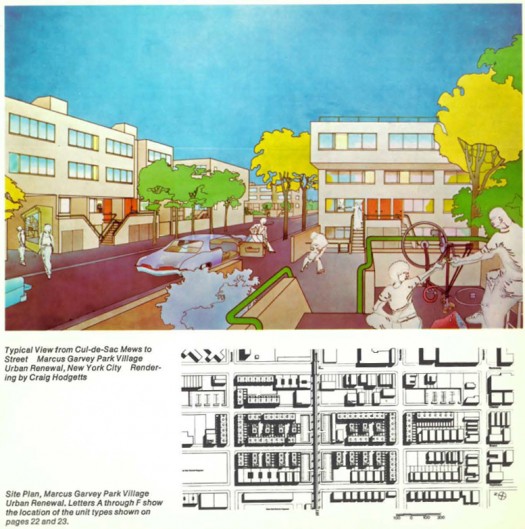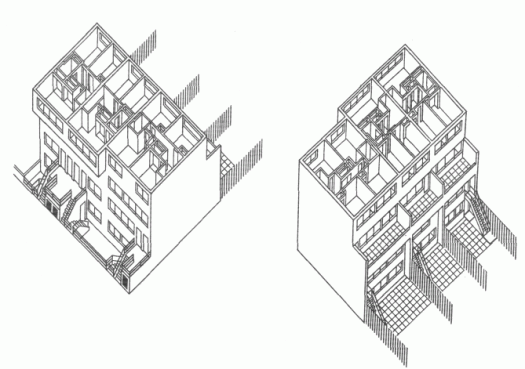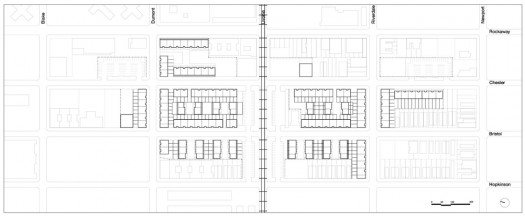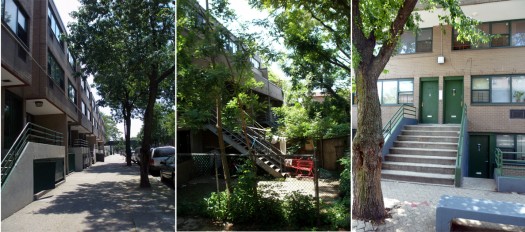
Celebrate ten years of Urban Omnibus and support ten more years of fresh, independent perspectives on citymaking with a donation today!
Celebrate ten years of Urban Omnibus and support ten more years of fresh, independent perspectives on citymaking with a donation today!
Next year, architect and researcher Karen Kubey will mount an exhibit, entitled Suburban Alternatives, that will trace the typology of low-rise, high-density housing over time. Over several years of research, Kubey has amassed case studies and oral histories with architects from Europe and the United States that explore the social, ecological and architectural ideas embedded in this particular type of housing. One revealing example of the type is right here in Brooklyn: Marcus Garvey Park Village in Brownsville. In revisiting this project and arguing for its reconsideration, Kubey sketches some of the complex history of a typology intended as “the best of both worlds: dense enough to achieve urban benefits such as access to public transportation and civic and commercial amenities, while also providing a sense of individual identity for residents and accommodating an integration of open space.” While inventive New York examples of low-rise, high-density housing have not always been completely successful, these projects contain valuable lessons for housing design that meets contemporary needs and raise important questions of how to evaluate success in both architecture and policy.
Kubey’s essay is the first in a pair of Urban Omnibus features that explore significant, under-represented examples of New York as an innovator in housing form and policy. Next week Susanne Schindler and Juliette Spertus will compare the design thinking behind two high-density developments in the Bronx, Co-op City and Twin Parks. In light of recent demonstrations of the political will to innovate once again, these cases testify that future innovation must be informed by nuanced understanding of past experimentation. –C.S.
LEARNING FROM A HISTORY OF HOUSING EXPERIMENTS
New Yorkers’ housing needs and desires are diverse; so too is New York’s housing stock. From Midtown Manhattan high-rises to single-family homes in Bayside, Queens, New York is host to every major housing typology. And housing for low-income and working-class residents, in particular, has traditionally served as a laboratory for new ideas in architecture. In New York, these have ranged from the model “dumbbell” tenement design of 1878, to tower-in-the-park public housing of the 1930s to 1970s, to, most recently, green design-focused projects such as Via Verde in the Bronx. Contained within each of these experiments are architectural lessons — both positive and negative — on how to address the social and environmental challenges that accompany housing design for any demographic group and how to provide the right mix of typologies to accommodate the diversity of real estate demand. Among the range of housing typologies needed to accommodate that diversity, low-rise, high-density housing especially deserves our reconsideration.
Low-rise, high-density housing is among the most sought after in the city. Beloved brownstones in areas like Brooklyn’s Park Slope and Manhattan’s Upper West Side are typically about four stories tall and 50 units to the acre. The desire for public transport access, low-rise buildings and open space within housing developments translates to demand for low-rise, high-density housing, even if the term itself is not in common usage (transit stations are viable only with housing of at least 20 units per acre, according to the U.S. Environmental Protection Agency). While housing of this type continues to be built in parts of New York and, even more so, in suburban infill projects across the country, it has a complicated history and a mixed record of “success.” In the 1960s and 1970s, the typology became popular among architects as a reaction to the apparent social failures of high-rise, “tower-in-the-park” schemes, then typical of publicly-funded housing and urban renewal projects. But decades have passed since architects and developers have collectively focused on creating innovative housing models of the type.
As architect and Columbia professor Kenneth Frampton described in a 2008 interview, “Low-rise, high-density housing was really a compromise” between suburban-scale and multi-story housing, “but it was also a solution that would be much more economical in terms of land-use and which would have many social advantages in terms of services, and at the same time provide for very close contact with the ground and with nature.” Proposed at the time as viable for both suburban and urban sites, low-rise, high-density housing attempted to bring together the best of both worlds: dense enough to achieve urban benefits such as access to public transportation and civic and commercial amenities, while also providing a sense of individual identity for residents and accommodating an integration of open space. To study existing cases of the typology, architects of the era made pilgrimages to seminal projects such as Atelier 5’s 1961 Siedlung Halen on the outskirts of Bern, Switzerland, which was inspired heavily by Le Corbusier’s 1948 Roq et Rob scheme, an unbuilt low-rise, high-density project proposed for Roquebrune-Cap-Martin in the South of France.
During its short tenure as a housing production agency from 1968 to 1975, New York State’s Urban Development Corporation (UDC) led the creation of cutting-edge housing for low- and middle-income populations, in collaboration with some of the best architects of the era. Governor Nelson Rockefeller, in the wake of Martin Luther King Jr.’s assassination, pushed through legislation creating the UDC as a superagency with “unbelievable powers” of eminent domain used “basically to take land and build housing for poor people,” as UDC Chief Architect Ted Liebman described its influence in a 2010 interview with architectural historian Kim Förster, published this February in Candide.
In just seven years, the UDC created 33,000 units of housing of a range of types and was a proponent of low-rise, high-density housing, developing projects like Werner Seligmann’s Elm Street housing in Ithaca and Marcus Garvey Park Village in Brownsville, Brooklyn. At the time the UDC ceased the production of housing in 1975, Liebman had assigned seven young firms to develop further the low-rise, high-density housing model on sites across New York State. But without government funding, the focused study never came to fruition.
MARCUS GARVEY PARK VILLAGE
Likely the most celebrated low-rise, high-density housing project of its era in the United States, Marcus Garvey Park Village, built in Brownsville between 1973 and 1976, was the result of a unique collaboration between the Institute for Architecture and Urban Studies (IAUS), the architectural think tank headed by Peter Eisenman; the Urban Development Corporation; and the Museum of Modern Art’s Department of Architecture and Design (MoMA), directed by Arthur Drexler, who also served as Chairman of the Board of the IAUS. The alliance provided the chance for the architects of the IAUS and the UDC to produce and publicize integrated theoretical and built work, and for MoMA to engage in pressing issues in housing and urban design. As Förster wrote in Candide, the partnership facilitated “not only socially relevant, but also high-quality architecture,” with the IAUS acting as “mediator between the established academic, cultural, and political players.” Marcus Garvey is the only built project ever produced by the IAUS, an organization known more for its intellectual contributions to the field of architecture.

Detail from the catalog for Another Chance for Housing: Low-Rise Alternatives, Museum of Modern Art, 1973
MoMA celebrated the project with an exhibition opening the same day as Marcus Garvey broke ground, entitled Another Chance for Housing: Low-Rise Alternatives. The show presented the IAUS and UDC’s low-rise prototype alongside its two proposed built applications: in Brownsville and another project for Fox Hills, Staten Island, that would never be realized. Another Chance for Housing also included a polemical essay by Kenneth Frampton, architect of Marcus Garvey with the IAUS, “The Evolution of Housing Concepts: 1870-1970,” in which he presented the UDC’s housing projects to date and argued for low-rise, high-density housing as a mediator between urban and rural ideals.
The construction of Marcus Garvey began a year after Pruitt-Igoe, the famously unsafe and poorly maintained high-rise, public housing project in St. Louis, was imploded in a public spectacle, forty years ago this month. At the time, the architecture of Pruitt-Igoe was blamed for the project’s demise, which remained a symbol of the failures of high-rise housing projects across the country long after its demolition. In response, architects and city planners sought new approaches to increase the safety of housing developments through design. The low-rise, high-density housing movement of the 1960s and 1970s rallied in opposition to the perceived anonymity of so-called “towers-in-the-park,” decrying the typology’s unarticulated open space. As Frampton argued in his essay in Another Chance for Housing, “A rambling green carpet set at grade, flowing out between isolated buildings, was thought to make amends for any loss of enclosure and, in the case of high rise structures, to more than compensate for an inherently unsatisfactory relation to the ground.” Oscar Newman’s widely-read Defensible Space was published in 1972, and the UDC and IAUS’s design criteria, though less safety-obsessed than Newman’s, showed a similar faith in the power of architecture (and specific architectural typologies) to fix social problems.

An axonometric diagram showing the arrangement of proprietary open space and front stoops of Marcus Garvey Park Village | Image courtesy of totalarch.com
TODAY
When I visited Marcus Garvey Park Village, I approached from the elevated subway line along Livonia Avenue that bisects the project’s seven-block site. 626 one- to four-bedroom apartments are stacked and arranged in east-west and north-south rows of a uniform four stories, built in concrete and faced in light brown brick. Adapting the low-rise prototype to the unique site, the housing is set back 100 feet from the subway track to protect against noise, with parking at-grade. At 55 units per acre, Marcus Garvey is actually denser than its neighboring Van Dyke housing towers of 50 units per acre. Where large-scale housing projects of the era typically consolidated existing urban fabric into superblocks, Marcus Garvey was ahead of its time, not only maintaining the site’s existing street grid, but also incorporating a series of pedestrian streets and courtyards within the development, called “mews.” Some units’ front doors and stoops open onto the mews; others open onto the street, forming street walls along the edges of each block that are, as Frampton describes, “interrupted in a syncopated way” by the 50-foot mews. The project presents a clear rhythm of built and open space.

Site plan for Marcus Garvey Park Village (click to enlarge) | Image by Andrea Simone based on the original plan by the Urban Development Corporation and the Institute for Architecture and Urban Studies
Un-gated, the site is accessible to the public and scaled to give the feeling of traditional row houses or brownstones, but with a clean, modern aesthetic. The openness of the site contrasts sharply with contemporary gated communities and condos whose open space is accessible only to residents, separated from the surrounding built fabric. Marcus Garvey residents enter the apartments through green front doors located a half-level below grade for the lower units; apartments above are entered atop wide, concrete stoops. Lower units have small, private backyards separated by chain-link fences, as opposed to the original design for solid brick dividing walls. When I visited Marcus Garvey with Kenneth Frampton and fellow researchers Kim Förster and Suzanne Frank, wandering from the subway to the street to the mews, I felt at once part of the city and connected to the project’s smaller neighborhood. The design’s attention to semi-public space, incorporating the vernacular elements of stoops and mews, provides a seamless transition from the street grid to the internal circulation.
Although the 1973 design is still largely intact, the project shows evidence of lapsed maintenance: backyards and parking lots are overgrown and look unused, and exterior electrical wires are draped between buildings and across façades. UDC, disbanded by the time of Marcus Garvey’s completion, turned the development over to a private management company, which, according to visual evidence and resident reports collected by then-Harvard student Anna Fogel in 2007, has failed to maintain the property in good repair. Marcus Garvey’s mews have been criticized for effectively shielding criminal activity from the view of police. Ironically, the pedestrian areas were inspired by an eyes-on-the-street, safety-oriented design concept.
Evaluated in terms of UDC’s seven original design criteria – “sense of community, child supervision, security, maintenance, livability, responsiveness to context, and flexibility” – Marcus Garvey’s ongoing of challenges of maintenance and crime point to mixed results. But separating the fate of the project from the economic and social context of Brownsville — with traditionally high rates of poverty, crime and disinvestment — is impossible. And the inconsistent emphases of housing policy in the United States, especially President Nixon’s 1973 moratorium on federal funds for subsidized housing programs, contributed to a pattern of institutional and governmental neglect. However, in terms of UDC President and CEO Edward Logue’s goal for the prototype, to “afford not only a sense of individual identity but also a sense of community,” the project’s success is undeniable. A 2004 environmental psychology study of Marcus Garvey by Susan Saegert with Gabrielle Bendiner-Viani, published in a 2007 article in Places, found that most resident “respondents thought the designers were successful” in creating quality housing. A contemporary version of the project would require both sufficient support for design and building and financial considerations for long-term maintenance.

Marcus Garvey Park Village, from left: street-facing units; private backyards; mews units with stoop | Photos by Karen Kubey
Forty years after its completion, the faith in architecture’s ability to redress social challenges, so evident in projects like Marcus Garvey Park Village, has waned. These days, we rely on the power of policy and economics to determine the success of any given architectural project. The high-rise typology has also been reconsidered, as plenty of examples of successful housing towers demonstrate across the country. Low-rise, high-density housing is still being developed all over America, but often to a lower design standard than projects from earlier eras or from abroad. Today, many projects funded by HOPE VI, the program of the U.S. Department of Housing and Urban Development that favors low-rise housing, and of the New Urbanist movement, which promotes dense, transit- and pedestrian-friendly communities, are technically low-rise, high-density, but fail to extend design lessons from earlier housing experiments of the type. Many adopt the nostalgic aesthetic of middle-class, suburban America and fail to articulate a scheme’s open space beyond private front and back yards. The social and environmental ideas embedded in the best examples of the low-rise, high-density typology are particularly relevant in the context of densifying American suburbia, offering an economical use of land, a physical connection to the ground, and a level of density supporting public transport.
In New York City today, low-rise, high-density housing is economically viable only in areas where zoning does not permit taller buildings, mostly in low-income or “emerging” neighborhoods in Brooklyn and Queens. As New York housing developer Jack Heaney, of Fulcrum Properties, put it, the city’s low vacancy rate means that “no one’s going to build a four-story building where you can build an eight-story one.” A building of four stories does offer cost savings compared to taller structures, as New York housing less than five stories tall can be built without an elevator and using block-and-plank construction. And in predominantly low-rise urban and suburban areas across the country, tall buildings are often neither financially feasible nor desirable additions to the built character of a neighborhood.
Suburban infill developments and accessory dwelling units, in which a formerly single-family property accommodates additional housing units, are bringing to life hypothetical dense housing proposals of the 1970s. Higher density means lower land cost per unit, a point emphasized in U.S. government-sponsored literature encouraging density in areas where zoning laws, subdivision regulations, and resident preferences have often prevented the building of dense housing. While architects and developers constantly produce new housing, the lack of connection between contemporary suburban infill projects and the designs and research of a previous generation is unfortunate. And though conversations around Foreclosed: Rehousing the American Dream, the MoMA suburban housing show of this year, co-curated by Columbia University’s Buell Center, or Retrofitting Suburbia, a 2008 book by Ellen Dunham-Jones and June Williamson, among other examples, have included discussions of recent and proposed low-rise, high-density projects, the need to examine historical experiments remains, especially if we are to raise the bar for housing design and policy to respond to contemporary needs.
Low-rise, high-density housing is not, and never was presented as, a cure-all. But the typology remains viable and desirable in many suburban and some urban contexts, and points to a wider range of housing typologies that need to be developed, and should be informed by a deeper understanding of this often built, but under-studied type.
The views expressed here are those of the authors only and do not reflect the position of The Architectural League of New York.
Comments